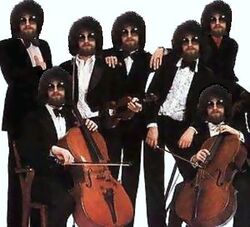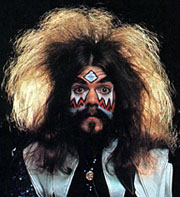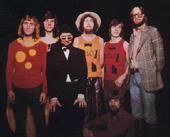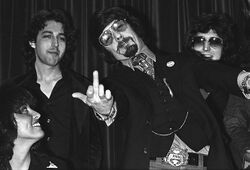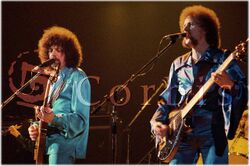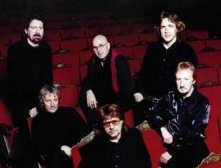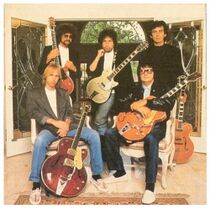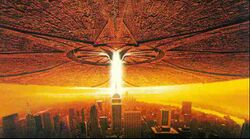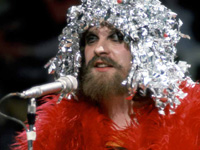ELO
“Who?”
Excessive Lynne Orchestrations (ELO) is a hugely successful British progressive pop-rock group formed in Birmingham, England in 1971. Fronted by reclusive facial hair enthusiast Jeff Lynne Otis Wilbury and managed by notorious mafia boss Don Hardonn, they placed no less than 54,678,002 singles on the US and UK pop charts from 1972 to 1986, yet are essentially unknown to the general public today.
Fortunately for Otis, the few people who do remember ELO all work in the advertising industry, with the result that their songs appear in several dozen television commercials and movie trailers every year. The royalty income this produces for Wilbury allows him to champion the careers of up-and-coming unknowns like Paul McCartney and Tom Petty by overproducing their albums.
The History of ELO[edit]
1965–69: The Mauve[edit]
ELO began as a side project of The Mauve, a mid-late 1960s British pop group fronted by Roy "Morning" Wood and featuring drummer Bebe "Butch" Buell. A series of controversial publicity stunts such as eating automobiles one piece at a time and assassinating the Prime Minister pushed singles such as "The Ceiling Is Melting (Despite Me Drug-Free Lifestyle)", "Penny Fields Forever", and "Do Me" to the top of UK charts. Unfortunately, nobody in America ever heard of them except Todd Rundgren, Cheap Trick, and three music critics (none of whom were named Lester Bangs).
When The Mauve's frontman Carl Vain tried to move the band in the direction of contemporary Christian musical theatre, he was unceremoniously replaced with Jeff Lynne, a fuzzy-haired chap with a goatee who had fronted an unsuccessful white power pop group called The Master Race. Lynne only joined The Mauve with the understanding that they would form a side-project called "ELO", jump on any offers that they received to make music for roller disco exploitation films, and never, ever photograph him with his sunglasses off. Jeff, Roy, and Bebe then recorded the last Mauve album, Freedom from the Contract, and prepared for the next step.
1970–73: The Obscure Years[edit]
Here the chronology grows a little fuzzy, because tracks for the first ELO album were recorded during the same period — and sometimes during the very same studio sessions — as The Mauve albums Lookie Here and Freedom from the Contract, the Roy "Morning" Wood solo album Over the Shoulder Boulder Holder, Bebe's solo album More Songs About Football and Gay Men and, of course, Chinese Democracy.
Lynne and Wood used the same methodology to produce the first ELO album that they had perfected on the last two Mauve albums: Basic tracks were recorded, then a second basic track was overdubbed on top of the original basic track, then Roy would overdub cellos, a ten minute sitar solo and about fifty billion oboes. Finally, they would wipe away both of the basic tracks and overdub even more goddamn oboes. When it was decided that something more was needed in the mix to offset all those fucking oboes, they hired Steve "Wooly" Woolam to play violin and, subsequently, gave him a glowing reference for a sheep-shearing job. The band's 1971 debut album was released as LOL, It's ELO in the UK and, due to a misunderstood phone message, No Answer in the US. "Dear Prudence Overture" was released as a single and, tragically, resulted in Jeff Lynne appearing on Top of the Pops dressed as a gay pirate.
During the recording of their second album, 1973's ELO Too: Electric Light Boogaloo, Roy "Morning" Wood was ousted from the band by drummer Bebe Buell, who claimed that "The Riot of Stonewall Moor" was irrefutable proof of Wood's second life as a transvestite prostitute at medieval fairs and felt threatened by Roy "always checking out [his] junk". ELO Too, in a nod to the "boring rock" movement then in fashion, consisted of only five excruciatingly long songs, including "Jeff's Boogaloo #1", "Jeff's Boogaloo #2" and the perky, light-hearted anti-war song "Kia" (which would later be used as the soundtrack to a Toyota commercial). The big hit, though, was their cover of Chuck Berry's "Rock (& Roll) Me Amadeus" (later covered again by Mr. Radio Head).
1973's On the Third Day, which was, in fact, recorded on a second day, featured a return to short, radio-friendly songs, which were then linked together in suites with tuneless interludes to please the "boring rock" devotees. "Slow Down", a soul-influenced song that Jeff Lynne originally wrote for a premature ejaculation PSA, became a hit and was warmly endorsed by a heavily drugged John Lennon. Unfortunately, the album was poorly distributed in America due to a cover that featured all seven members of ELO exposing their navels.
1974–78: The Ubiquitous Years[edit]
Lynne first used a full orchestra (as opposed to an orchestra that had not yet eaten dinner) on 1974's Eldorado, a concept album about a man who visits his fantasy world in a Cadillac and buys spinners for said Cadillac. It spawned not one but two US hits, "Boy Blew (Hey, He Needed the Money)" and "I Wish I Could Get This Damn Song Out of My Head". Unfortunately, the experience of working with a British orchestra was disheartening, as their collective flatulence rendered dozens of takes (and the studio itself) unusable. Lynne would subsequently flee to Germany, where he would create his most commercially successful work under the watchful eye of legendary one-named engineer Madonna. Also around this time, cellist Pike Edwards left the group and set up a Buddhist grapefruit and hay bale farm, cruelly brought to an end when a runaway Ford Transit van came tumbling over a hedge and smashed into Edwards whilst he was out gathering hay.
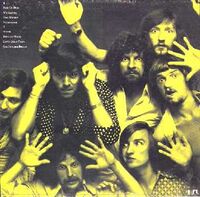
Shortly after recruiting midget bass player Kelly Groucutt, whose undistinguished stylings would take the band well into the 1980s, ELO decamped to Arbeit Macht Frei Studios to record 1975's Faceless Music. Hits like "Evil Woman" and "Estranged Magic" took the album into mega-platinum territory, while controversy erupted over so-called "secret messages" (opening track "Fire on High" featured a backwards recording of drummer Bebe Buell saying, "Oi! Yer all a bunch of bleedin' poofs").
Expectations (and listeners) were high for the follow-up, 1976's A New Weird Record. Radio was saturated with Jeff Lynne compositions like "Telephone Lynne" (five minutes of a bullhorn feeding back), "Ain't Nuthin' But a Livin' Thang" (long rumoured to be a protest against stem cell research), and "Supercalifragilisticexpirockaria!" (decried by critics as "something quite atrocious"). In an unexpected turn of events, The Mauve's final hit, "Do Me", was reworked, the guitar-bass-drums minimalism of the original replaced with a full orchestra and choir, a legion of bagpipers, and the chanting of Tibetan monks. Believe it or not, that became a hit, too.
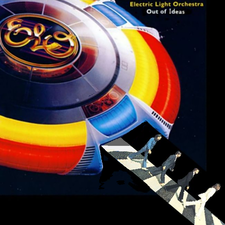
The commercial and artistic zenith of ELO's career was 1977's Out of Ideas, a double album lavishly packaged with a poster, full lyrics, a die-cut model of the Mothership, a roach clip, a lunchbox, Silly String, an afro pick, and a Jeff Lynne Pez dispenser. The cover, with its ominous portrait of the Mothership hovering over the Earth, influenced filmmakers like George Lucas and Steven Spielberg to make movies about, like, space and stuff. The musical contents were no less spectacular; "Turning Stoned", "Street Walkin' Woman", and the bleak, relentless death march of "Mr. Blue Sky" occupied all positions on the Billboard charts that weren't already taken by the Bee Gees.
ELO toured relentlessly through 1977 and 1978, aided by the construction of a real-life Mothership based on the Out of Ideas cover. In fact, they never actually left the Mothership; they just beamed their performances down to selected cities. Eventually they just started miming to studio recordings, but dropped the miming when they realised they couldn't be seen anyway. Critics called these concerts "impersonal and anonymous" and started raving about The Velvet Underground.
But Jeff Lynne was not yet content. He wanted to dominate the charts without any competition from the Bee Gees. To this end, he convinced the brothers Gibb to star in the Sgt. Pepper's Lonely Hearts Club Band movie and retooled ELO for disco. Oh snap.
1979–86: The Other Obscure Years[edit]
“One one hand, Out of Ideas was a tour-de-force double album loaded with radio-friendly ear candy. On the other hand, Discovery is totally lame.”
Recorded under the working title Blondes Have More Fun on Shakedown Street than a Dynasty of Some Girls, 1979's Discovery found ELO exploring dance beats (just like the Bee Gees) and sappy ballads (just like the Bee Gees). Hits included "Smell a Little Glove", "The Diary of Horace Wimp", and "Won't You Go Down, Bruce". That last number was recorded at the last moment when it was helpfully pointed out that everything else on the album sucked. It also established the tradition of placing some tired old rockabilly retread at the end of every subsequent ELO album (to be extracted as a single, natch). ELO recorded a music video of the entire Discovery album, in which they wore satin shirts, pranced about in front of rainbows, and, during "Man Train to London", fellated The Village People. Drummer Bebe Buell, who appeared in the video with a terrible perm, a flowing velvet robe and a foot-long cigarette holder, will punch anybody who so much as mentions it.
In 1980, ELO were asked to contribute half the soundtrack of Xanadu, a roller-disco-fantasy-Western-sci-fi film starring Olivia Newton John as Geddy Lee, Gene Kelly as Samuel Taylor Coleridge, and Michael Beck as that guy from The Warriors. Lynne foolishly rejected the offer and, of course, Xanadu went on to break box office records, sweep the Oscars, and regularly top Entertainment Weekly "bestest movie of all time forever and ever" polls. Most ELO fans believe that this caused Lynne to sink into a deep depression and "phone in" the next three albums.
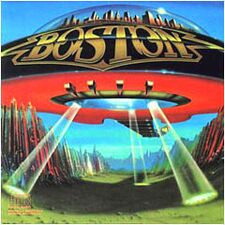
1981's Thyme was a lot like Eldorado, except that this time around, the Cadillac was a time machine, the dream world was the future, and the orchestra was Gary Numan. Hits included "Gro-Light", "Yours Truly in the Year 2525", and "That Song David Bowie Danced To In Those 'Coffee Achievers' Commercials (Why Didn't They Just Use A David Bowie Song Or, Conversely, Show Jeff Lynne Dancing?)" (Tired Old Rockabilly Retread #2). Another controversy erupted when it was rumoured that teenagers were getting high from smoking the herb thyme in honour of the album, but it turned out that teenagers weren't even listening to ELO anymore and what they were smoking was just harmless marijuana.
Jeff Lynne had always enjoyed writing in exotic locales, and this time around he decided to give Bangkok a try. The resulting 1983 album, Secret Massages, was originally conceived as a double album (because it would fulfill ELO's contractual obligations) but was distilled down to a single disc (because nobody cared about ELO anymore). A despondent Jeff picked out the best songs and placed some of them on B-sides while saving the rest for future box sets. The remaining tracks (including Tired Old Rockabilly Retread #3, "Rocky Road Is Keen") were rerecorded in a minimalistic style at Lynne's house and released as a single disc. Oh yeah, and if you bought the cassette or CD, you got a bonus track, but it was just another dumb song about smoking thyme.
At this point, Lynne was fed up — and who wouldn't be! It was now the 1980s, and music seriously sucked ass. Lynne, pop genius that he was, came up with a post-modern masterpiece of an idea: He would record a parody of '80s music so hideously over-the-top and tasteless that nobody could possibly take those production techniques seriously afterward. To that end, he used electronic drums, a Yamaha DX-7, samples, digital reverb, and a "saxophone". I mean, that really, really annoying '80s saxophone. You know the kind I'm talking about — it always sounds a lot like "Old Time Rock and Roll" by Bob Seger and makes you want to hit yourself in the forehead with the pointy end of a claw hammer. Yeah, that's the one.
But Jeff did his job too well. Neither critics nor fans nor the larger mainstream audience understood the satirical nature of ELO's last original album, 1986's Fulfilment of Contract. All they heard was a seriously cheesy album (although — let's be honest here — no cheesier than just about anything else from that time). Jeff Lynne's desperate warning was ignored, and the world was conquered by Starship's Knee Deep in Your Hoo-Ha. With the final strains of "Bend It" (Tired Old Rockabilly Retread #4), ELO was no more.
Afterglow and side-projects[edit]
ELO Part Deux[edit]
After Lynne abandoned ELO, drummer Bebe Buell gathered together several former members and several talentless unknowns to form ELO Part Deux. They were nearly as cool as post-John Fogerty Creedence Clearwater Revival and post-John Bonham Led Zeppelin.
For the next ten years ELO Part Deux toured playing cool versions of Jeff's songs, and they released new cool records as well: ELO Part Deux (1990), Waste of Effort (1994; also known as Moment of Recording a New Disc Pretending to Be ELO), and No Refund (2001), all of them critically acclaimed for the way they made ELO sound just like Toto.
ELPs (Excessive Lynne Productions)[edit]
Lynne, who had already helmed the board for albums by Three Stooges producer Del "Lord" Shannon, rockabilly revivalist Dave "Edmund" Fitzgerald, and Run DMC, wanted to break into production full-time. To this end, he broke into George Harrison's house and held the ex-Beatle at knifepoint until he agreed to cut an album. The resulting disc, 1987's Strych Nine, was critically acclaimed for the way it made George sound just like ELO.
Lynne was now traveling in rarified circles, giving him much-needed access to other famous musicians he could hold at knifepoint and produce. Roy Orbison and Tom Petty alike surrendered to Jeff's blade and gated drum sound, and the resultant albums, The Diary of Mr. E. Blue Kingdom Radio Girl and Pull My Finger, were critically acclaimed for the way they made Roy and Tom sound just like ELO.
The Traveling Wilburys[edit]
In the late 1980s, Harrison, Orbison, Petty, and pseudo-poet Bob Dylan held an intervention to stop Lynne's addiction to knifeplay. Thirty seconds into the intervention, Lynne — now calling himself "Otis Wilbury" — held all four at knifepoint until they agreed to form a laid-back supergroup of sorts called The Traveling Wilburys. The resultant albums, Greatest Hits (their debut) and Daed Si Yor (which sparked the "Roy Is Dead" hoax), were critically acclaimed for the way they made all five of them sound just like ELO.
Bored one day in 1990, Wilbury held himself at knifepoint and recorded a solo album, Mystery Armchair Theatre. It consisted mostly of Otis playing snippets of really bad albums, then overdubbing humorously sarcastic and erudite comments with the help of two robotic sidekicks. The album was swiftly removed from shelves after a lawsuit from a Gizmonic Institute employee by the name of Joel Hodgson, but was critically acclaimed for the way it made Wilbury sound just like ELO.
Finding himself on the other end of his own knife was a shattering experience for Otis. "So that's what it's like," said Otis, "quite frightening, actually." Wilbury vowed never again to wield a knife and, incidentally, spent the next four years producing absolutely nobody.
The Threetles[edit]
1995 was the year that Otis decided to take pity on a struggling, obscure band from Liverpool called The Beatles, who were already gaining critical acclaim for sounding just like ELO. His production duties were made more challenging by the fact that one of the band's members, John Lennon, had been shot to death by an enraged Jesus Christ (in his terrestrial form, Mark David Chapman) way back in 1980. Emerging digital ouija board technologies made it possible for John to participate in the project, but it has to be admitted that Lennon's voice, aurally degraded by transmission from the astral plane, ended up sounding like a poor-quality cassette recording. Most of the resulting Apology series sounded like a bunch of outtakes that weren't intended for commercial release, but the two tracks Otis produced were critically acclaimed for the way they made The Beatles sound just like ELO.
Paul McCartney, suitably impressed by Wilbury's work with his old band and mindful of the fact that he might soon need that emerging digital ouija board technology to contact his wife Linda, asked Otis to produce a few tracks for his 1997 album 3.14159 on Fire. Although the results were critically acclaimed for the way they made McCartney sound just like ELO, Wilbury was growing restless. He was tired of producing albums that sound just like ELO and watching somebody else get the credit. The time had come again to produce an ELO album and make it sound just like ELO.
The Second History of ELO[edit]
2001: Don't Call It a Comeback, or, The Most Obscure Years[edit]
So in 2001, Otis Wilbury recorded a solo album that sounded just like ELO, with guest appearances by two ex-Beatles, George Hare Krishna and Gringo Starfish, and of course his then-girlfriend Stevie Nicks who threatened to throw a major hissyfit if her boyfriend wouldn't allow her to sing on it. Titled C'mon and Zoom, Zoom, Zoom-a-Zoom, it was marketed as an ELO "reunion" album and sold about 327 copies.
In a fit of pique, Otis obliterated 37 major American cities with the doomsday device installed on the new ELO Mothership before Will Smith managed to infect the vessel with a computer virus that triggered its self-destruct sequence. Wilbury escaped and was holed up in his studio, sequencing box sets, dusting off unreleased tracks to put on reissues, and just generally plotting his revenge against a cruel, uncaring world.
2014–present: Coming Back, for Realz[edit]
In 2014, Otis made a comeback from the studio, much to the surprise of shocked peeps in the street, and announced that ELO was coming back, this time under the humble moniker of Otis Wilbury's ELO. This announcement triggered widespread panic; in London, every shop was closed and transportation systems were hectic, with citizens worrying that the ELO Mothership would decimate them again. In an interview, Otis confirmed that the album would be titled Ayyyy, We're Back Yet Again for Another Zoom-a-Zoom Adventure!; this uncreative title choice disappointed many fans and caused riots in Manchester, prompting Wilbury to do damage control and rename the album Alone in the Dark Universe. So Otis recorded the album in Brum with his mates and presented it to the world in 2015. Then, he presented the single as if it were the Bible... and it, the proud work we had been waiting for, was called "When I Was A Boy, I Was A Baby, An Annoying Tween, Then an Adult". The world cheered; all of a sudden London and Manchester came together and just rebuilt themselves again, but as a result Glasgow and Edinburgh collapsed, not to be seen again until a billion years had passed.
In 2019, ELO rather unexpectedly released the album From Out of Nowhere, an appropriate title since the album came at a time when nobody expected it. The album was a collection of A New Weird Record and Out of Ideas pastiches, and was forgotten a week after release. As with Zoom, Otis played virtually every single instrument on the album, save for on the song "One More Time" where he threw Richard Radioshack a bone and let him play a piano solo. The musty, motionless ELO Mothership on the cover perhaps clued listeners in as to how much inspiration Wilbury spent on this one.
Members[edit]
- Enduring classic lineup
Although ELO has undergone many lineup changes over the decades, the core of the group during its most commercially successful period (1975–1979) consisted of:
- Jeff Lynne – the Main Dude, plus lead and backing vocals, guitar, bass, cello, keyboards, drums, percussion, sunglasses, producer, songwriter, composer, arranger... hell, everything on Zoom and From Out of Nowhere! (1970–86; 2000–01; 2014–present)
- Bebe Buell – drums, percussion, bass vocals, whale sounds, "The guy who pretended to play drums" and "Tea Boy" in 1986 (1970–86)
- Richard Radioshack – keyboards, Mellotron, vocoder, theremin, ostrich guitar, psychic piano, ARP 2500 Modular Polyphonic Syntesizing thingie, spiritual percussion, guitar when Jeff had a hangover and couldn't be arsed (1972–86; 2000–01; 2014–present)
- Kelly Groucutt – bass, girly falsetto vocals, four-string moustache (1974–83)
Members included Richard Tandy Bev Bevan, Kelly Groucutt and some other string dudes.
During this period their string section consisted of:
- The Violinist Who Looks Kind of Like a Depressed Jeff Lynne But Without the Sunglasses – violin (1973–79; 1981–86)
- The Fat Dope-Smoking Cellist – cello (1972–79)
- The Other Cellist Who Looks Like a More Effeminate Richard Radioshack – cello (1975–79)
- Other unimportant lineups
Currently Lynne Wilbury and Radioshack are the only remaining members of ELO, in addition to some no-name live sidemen. Other members from various points in the band's history include:
- Roy "Morning" Wood – the other Main Dude, plus lead and backing vocals, guitar, bass, cello, keyboards, drums, clarinet, bassoon, oboe, recorder, producer, songwriter, composer, arranger... hell, nearly everything on The Electric Light Orchestra and ELO 2: Electric Light Boogaloo (1970–72)
- Eric Clapton – ukulele (1970–72)
- Alfred Vivalda – accordion (1970–72)
- Steve "Wooly" Woolam – violin on first album, later took up sheep-shearing (1970–71)
- The Dad of That Guy from The Wonder Stuff – keyboards, French horn, hunting horn (1970–72)
- Michael D'Albacore – bass, harmony vocals, camel toe (1972–74)
- Worf Gibson – violin on second album (1972–73)
- Pike Edwards – cello; strings typically fingered with an orange or grapefruit (1972–75)
- Andy Panda – cello (1972)
- Colin "Imperial" Walker – cello (1972–73)
- Dave Moron – synthesisers, acoustic guitar, backing vocals (1981–86)
- Lois Clark Kent – orchestral arrangements, synthesisers, keyboards (1981–86)
- Kenny G – saxophone on Fulfillment of Contract (1986)
- Yamaha RY30 – drums on Fulfillment of Contract (1986)
